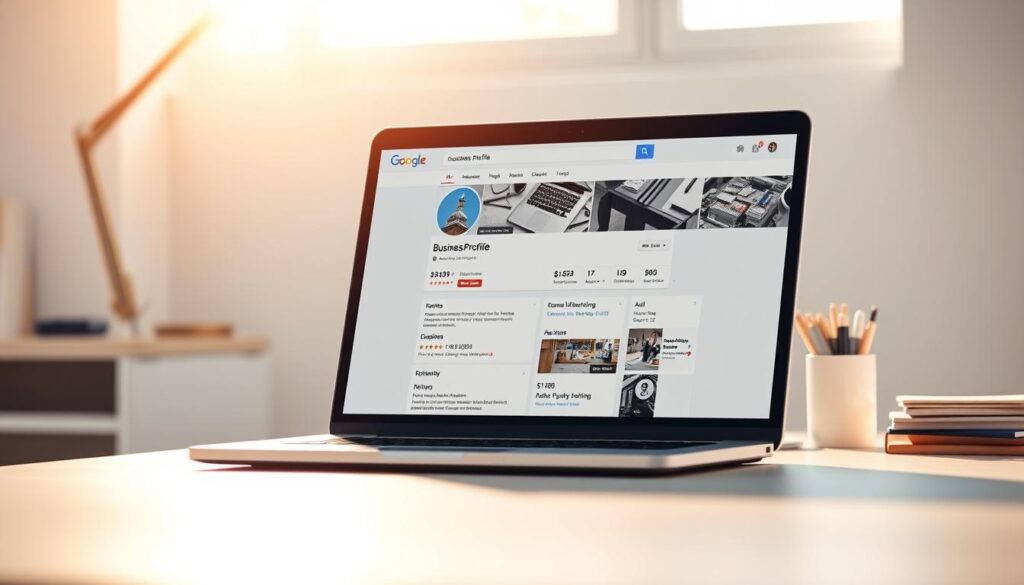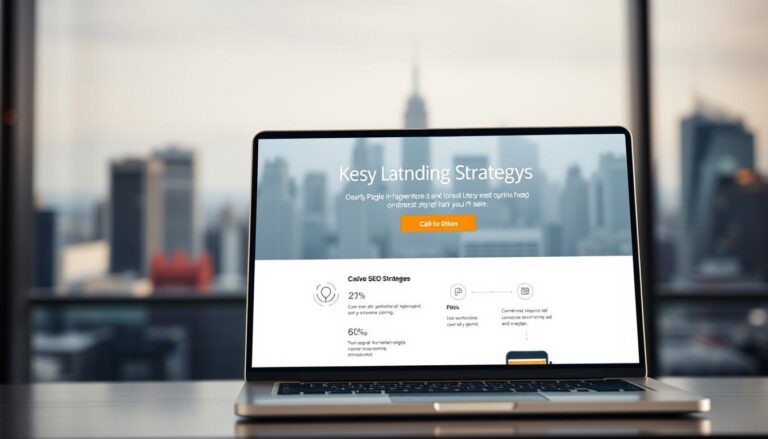This guide is a hands-on playbook for U.S. businesses that want more calls, direction requests, and foot traffic from nearby customers.
We cover practical steps you can run repeatedly: profile setup, review management, citation building across platforms like Yelp and Apple Maps, and on-page edits that match local intent.
The write-up also explains the technical backbone—indexing, Core Web Vitals, HTTPS, and mobile-first readiness—and why these factors affect how your pages and maps listing appear.
You’ll get workflow-ready checklists, examples, and tool suggestions for single-location, multi-location, and service-area businesses. The focus is ethical best practices, consistent tracking, and assigning owners so gains compound over time.
Key Takeaways
- Follow a repeatable strategy that includes profile setup, citations, reviews, and local-focused on-page work.
- Technical health—indexing, Core Web Vitals, HTTPS—directly impacts visibility and user actions.
- Structured data (LocalBusiness) helps systems read your name, address, and phone correctly.
- Track performance with GBP insights, GA4, and rank tools, then refine based on results.
- Apply ethical practices for reviews and links to protect long-term performance.
Why local SEO matters right now for U.S. businesses
When people add a city or “near me” to a query, they signal an urgency that can convert in minutes. These queries often mean the user wants a nearby solution now — for example, “24-hour plumber Detroit” or “best AC technician near me.”
Google’s Local Pack displays a map-based 3-pack with Call and Directions buttons. That layout cuts friction for users and turns discovery into immediate actions like calls, messages, bookings, or direction requests.
Businesses measure success by increased calls and directions as much as by website visits. Mobile users searching nearby behave differently than desktop researchers; mobiles often convert on the spot while desktop users compare options across a wider area.
- “Near me” and city queries show high purchase intent and often lead to phone calls or visits.
- Visibility in the map pack is fiercely competitive and changes block by block in dense cities.
- Consistent business info, photos, and prompt replies build trust and boost conversions from these surfaces.
Track profile interactions, not just site traffic. Winning top placements in google search and Maps directly improves foot traffic and revenue for many businesses, from restaurants to florists where direction requests closely match in-store sales.
Understand Google’s local ranking factors: proximity, relevance, prominence
Google ranks nearby results using three pillars: proximity, relevance, and prominence. These combine to shape which business appears for any given user.
Proximity is simply distance from the user. You can’t change where a searcher is, but you can set accurate addresses, map pins, and service areas to avoid being excluded.
Relevance reflects how well your listing matches intent. Precise primary and secondary categories, detailed services, clear on-page keywords, Q&A, and high-quality media boost relevance.
What you can influence
- Data accuracy: Keep NAP and schema consistent so systems reconcile your business correctly.
- Content and categories: Audit services, pages, and tags to match evolving customer queries.
- Prominence signals: Cultivate authentic reviews, quality citations, local backlinks, PR mentions, and community ties.
Track KPIs like radius-based rankings, pack impressions, and engagement rates to measure gains. Work the controllable items steadily to improve visibility and overall rankings on major search engines.
local search engine optimization checklist
A structured program helps teams collect accurate data, test changes, and measure impact across neighborhoods.
Use this seo checklist as a living workflow. Start with a data audit for every location, then optimize profiles and align the website content. Next, layer on citations, backlinks, and reviews while tracking results.
- Audit data: NAP, categories, pins, and duplicate listings.
- Optimize profiles: correct addresses, unique phones, and landing pages per site.
- Align website pages: map services to pages and add structured data.
- Layer citations, backlinks, and review programs with ongoing monitoring.
Assign owners for GBP updates, review replies, citation fixes, and outreach. Set weekly tasks for quick items and monthly cadences for audits. Use dashboards and tools to flag edits, duplicates, and performance drops.
Model notes: Single-location businesses use one public profile and footer NAP. Multi-location firms need one profile per address, unique phones, and dedicated location pages. Service-area businesses hide addresses and define clear zones. Avoid overlapping service areas for franchises — that can trigger filtering and drop visibility.
Centralize logins, document changes, and roll out updates in stages to isolate effects. Feed insights from sales and support into Q&A and content. Run quarterly audits to revalidate categories, citations, and competitor moves so your strategy keeps improving.
Set up and optimize your Google Business Profile
Claiming and verifying your listing gives you full control over the business information customers read. Do this first so you can lock fields, correct the name, and prevent unwanted edits.

Claim, verify, and pick categories
Claim or add the listing, then complete verification to unlock full access to the profile. Verified owners can reject incorrect suggestions and update key fields like phone number and hours.
Choose one precise primary category and add complementary secondary categories to reflect services. This improves relevance when people view your business on maps and listings.
Write description, add services and hours
Craft a concise description that highlights what sets your business apart and where you serve—avoid keyword stuffing. Add services and products with clear names and short descriptions.
Publish regular hours and holiday hours to prevent no-shows and trust issues. Audit entries often; Google may auto-add items that need correction.
Photos, posts, Q&A, and governance
Upload authentic photos and short videos of your team, space, and recent work. Link social profiles and your website to reinforce identity.
Seed Q&A with common queries and answer them proactively. Use posts for updates, offers, and events to keep content fresh.
- Assign primary owner and at least one backup.
- Set a weekly monitoring cadence for edits and reviews.
- Document change controls so updates follow a clear approval flow.
Manage reviews to build trust and improve rankings
Authentic reviews are a major trust signal that sway prospects and influence visibility for many businesses. Treat feedback as operational data and a public record of how you serve customers.
Choose priority platforms
Identify where your audience goes first. Add and optimize profiles on high-impact sites — Google Business Profile often leads, while Tripadvisor matters for tourism and hospitality. Keep core listings complete with accurate information and photos.
Ethical review generation
Make it easy for satisfied customers to leave a review. Use post-purchase emails with direct links, QR codes on receipts or signage, and embedded widgets on your site. Train staff to ask politely at the right moment and avoid incentives that violate platform rules.
Respond fast and professionally
Reply quickly to every review. Thank fans, address concerns, and offer clear next steps for unhappy users.
- Standardize prompts: transactional emails, printed QR codes, and onsite widgets.
- Build a response playbook with tone templates and personalization cues.
- Monitor star ratings, volume, and recency to track results and prominence.
Build accurate citations and keep NAP consistent
Build citations on trusted platforms—Yelp, Bing, Apple Maps, Tripadvisor, industry directories, and reputable local sites. These directories reinforce your presence and help search engines match your entity to queries.
High-quality directories and authoritative sources
Prioritize sites that fit your vertical and geography. Chambers of commerce, local media, and industry hubs often carry strong signals for businesses.
Detect and fix duplicates; enforce consistent NAP
- Enforce identical formatting of your name, address, and phone number everywhere so systems trust your data.
- Document canonical information centrally so staff and vendors publish the same details.
- Audit citations for mismatches, suppressed entries, or duplicates and correct them methodically.
- Include categories, short descriptions, and links to improve completeness and click-throughs.
Revisit listings quarterly to catch user edits, platform schema shifts, or stale information. Track how cleanup improves visibility across engines and avoid low-quality directories that clutter your footprint.
Earn local backlinks that move the needle
A focused outreach plan turns sponsorships, press, and testimonials into measurable links and referrals.
Events, sponsorships, press, and mentions
Host or sponsor community events and partner with charities or sports teams to earn editorial links from event pages and news write-ups.
Invite reporters and bloggers with newsworthy angles—openings, hires, or charity drives—to secure coverage and links that drive traffic.
Quality, diversity, and anchor text
- Map media, nonprofits, and associations where your business can add value and gain credible backlinks.
- Offer testimonials to vendors for attribution and convert unlinked mentions into proper links, prioritizing strong sites first.
- Publish selective press releases to trusted outlets and post job openings on relevant boards that commonly include links.
- Favor natural anchor text—branded or topical—and keep a varied profile across news sites, directories, and partner blogs.
Measure referral traffic, visibility lifts in target neighborhoods, and leads to validate the strategy. Follow Google’s link guidelines and focus on earning links—those earned links drive the best long-term SEO results for your business.
On-page SEO and keyword research for local intent
Effective on-page work starts with understanding what nearby customers actually type and why they click. Use tools like Semrush Keyword Magic, Keyword Gap, Google autosuggest, and Search Console data to collect geo-modified queries.

Find geo-modified terms (for example, “HVAC repair in Denver”) and map competitor gaps by comparing top-performing keywords and pages. Assign one primary keyword per page to avoid cannibalization.
Map keywords to pages
Place the chosen keyword in the title tag, meta description, H1, URL slug, and opening paragraph. Keep the URL concise — e.g., change a-guide-to-the-best-attractions-of-new-york to best-attractions-new-york.
Pages that convert
Design the homepage to answer “what you do,” “where you serve,” and “how to contact you” above the fold. Build service pages with scope, pricing cues, FAQs, and proof points.
Internal links and review cadence
Use internal links from blog posts to service and location pages to pass context and guide users to conversion. Monitor performance in Search Console and refresh underperforming content based on query trends and rankings.
NAP placement and LocalBusiness structured data
A clear footer NAP plus precise structured data is a small setup that yields steady gains in how your profile and pages are read.
For a single-location business, place a persistent NAP (name, address, and phone number) in the footer so contact information appears on every page. This reduces confusion and improves conversions.
Single-location footer NAP, multi-location hubs, and maps
Multi-location companies should build a location hub that links to unique pages for each branch. Each branch page needs complete NAP, directions, and an embedded map to aid navigation and reinforce proximity.
Implement JSON-LD with required and optional properties
LocalBusiness structured data helps systems interpret your entity and surface rich details. JSON-LD is easier to maintain; include required fields like name and address, then add optional properties such as hours, sameAs social links, and openingTimes.
- Use Google’s Structured Data Markup Helper to tag and generate code.
- Validate markup before deployment and align it with visible page content to avoid discrepancies.
- Establish a maintenance workflow: gather canonical business information, test in staging, deploy, and revalidate when hours or phone number change.
Run a technical SEO audit to protect visibility
A technical audit uncovers infrastructure issues that can block rankings and reduce calls or visits for your business. Start with a fast, repeatable review so problems get fixed before they hurt results.
Indexing, sitemaps, HTTPS, Core Web Vitals, and mobile-first
Use Google Search Console as your primary tool to verify which pages are indexed and why others are excluded.
Review Core Web Vitals to find slow or unstable pages and collaborate with developers on speed and UX fixes.
Confirm sitewide HTTPS and resolve mixed content; security affects trust and how your website shows up in search.
Validate and submit XML sitemaps that list only canonical, index-worthy URLs to help efficient crawling.
Security, manual actions, and ongoing error monitoring
Check for manual actions and security issues in Search Console and prioritize remediation to recover visibility.
Establish alerts for spikes in 404s, server errors, or sudden indexing drops, and document every fix.
- Ensure mobile-first readiness with responsive layouts and optimized assets for mobile networks.
- Schedule recurring audits and re-check impacted pages in Search Console after fixes.
- Align technical improvements with location page goals so the business benefits on phones and desktop.
Integrate audit outputs into your broader seo roadmap so technical debt is tracked and addressed. Small, steady technical work protects visibility and keeps your pages performing for customers and search engines.
Track local performance and iterate with data
Measure what matters: convert GBP interactions and website events into clear results your team can act on. Use those signals to prioritize tests and fixes that improve visibility and conversions for your business.
GBP insights: views, calls, directions, and interactions
GBP provides views, calls, messages, and direction requests. Track these metrics alongside photo views and messages to see which listings drive the most real-world activity.
Map and organic rank tracking across target locations
Use map-based rank trackers to measure rankings block by block. Compare grids versus competitors to find coverage gaps and prioritize pages or profile updates that move the needle on visibility.
GA4 and Search Console signals to guide next actions
In GA4, segment traffic by channel, city, and user intent to spot high-value pages. In Search Console, review impressions, clicks, and average position to find content opportunities and technical issues in google search results.
- Define KPIs: GBP calls, directions, messages, and website conversions.
- Build dashboards: combine GBP, rank trackers, and web analytics for quick action.
- Test and tie outcomes: link updates (descriptions, photos) to changes in results.
- Benchmarks: set monthly and quarterly goals and iterate based on data, not assumptions.
Your next steps to win local search in the United States
,
First, lock down verification and categories so your profile and hours match reality. Confirm owners and add photos, Q&A, and posts for trust and clarity.
Next, run a quick audit of reviews and citations. Standardize NAP, remove duplicates, and focus on the platforms that drive the most calls for your business.
Prioritize on-page work: homepage, service, and location pages need clear CTAs and relevant content. Add LocalBusiness JSON-LD and mirror visible details.
Complete a technical audit with Search Console, fix critical issues, and start GA4 plus a map rank tracker for measurable results.
Use this checklist as a living workflow: assign owners, set weekly and monthly cadences, track with dashboards, and review quarterly to refine your strategy and improve visibility for your business.










